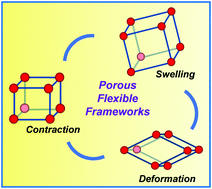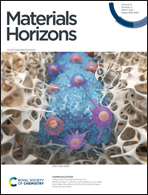Porous flexible frameworks: origins of flexibility and applications
Abstract
Porous crystalline frameworks including zeolites, metal–organic frameworks (MOFs), covalent organic frameworks (COFs) and hydrogen-bonded organic frameworks (HOFs) have attracted great research interest in recent years. In addition to their assembly in the solid-state being fundamentally interesting and aesthetically pleasing, their potential applications have now pervaded in different areas of chemistry, biology and materials science. When framework materials are endowed with ‘flexibility’, they exhibit some properties (e.g., stimuli-induced pore breathing and reversible phase transformations) that are distinct from their rigid counterparts. Benefiting from flexibility and porosity, these framework materials have shown promise in applications that include separation of toxic chemicals, isotopes and hydrocarbons, sensing, and targeted delivery of chemicals. While flexibility in MOFs has been widely appreciated, recent developments of COFs and HOFs have established that flexibility is not just limited to MOFs. In fact, zeolites—that are considered rigid when compared with MOFs—are also known to exhibit dynamic modes. Despite flexibility may be conceived as being detrimental to the formation and stability of periodic structures, the landscape of flexible framework structures continues to expand with discovery of new materials with promising applications. In this review, we make an account of different flexible framework materials based on their framework types with a more focus on recent examples and delve into the origin of flexibility in each case. This systematic analysis of different flexibility types based on their origins enables understanding of structure–property relationships, which should help guide future development of flexible framework materials based on appropriate monomer design and tailoring their properties by bottom-up approach. In essence, this review provides a summary of different flexibility types extant to framework materials and critical analysis of importance of flexibility in emerging applications.

- This article is part of the themed collections: Materials Horizons 10th anniversary regional spotlight collection: The Americas and Recent Review Articles


 Please wait while we load your content...
Please wait while we load your content...